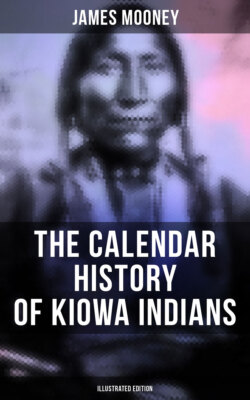Читать книгу The Calendar History of Kiowa Indians (Illustrated Edition) - James Mooney - Страница 61
На сайте Литреса книга снята с продажи.
Joint Delegation to Washington, 1872
ОглавлениеTable of Contents
An important object of the commission was to obtain a good representative delegation of the several tribes to visit Washington, with the view of impressing them on the way with the strength of the whites, in order to obtain a better understanding on their arrival. Although the other tribes generally responded promptly and satisfactorily, the Kiowa, as usual, were disposed to be perverse. At last, however, a party, including Lone-wolf, Woman-heart, Red-otter (Ápeñ-gúadal), Dohásän (son of the former great chief), Sun-boy (Paí-tälyí), Stumbling-bear, and others, met the commission on the Washita and consented to send delegates to Washington on the promise that their imprisoned chiefs, Set-t'aiñte and Big-tree, should be allowed to meet them at some point on the way, or that if five delegates were sent, the prisoners should be allowed to accompany them. A delegation had been selected to start for the east in September, when a rumor came of a movement of troops in the vicinity of their remoter camps, with the result that a number of the assembled Indians stampeded, including several of the promised delegates. The Kiowa delegation, as it finally left, consisted of four men—Lone-wolf, the head chief, Sun-boy, Gui-k`ate ("Wolf-lying down," improperly rendered "Sleeping-wolf") and one other. The Apache delegates were Pacer, Daho, and Gray-eagle.
BUREAU OF AMERICAN ETHNOLOGY—SEVENTEENTH ANNUAL REPORT PL. LIX
PHOTO BY LANNEY, 1892.
TSEÑ-T'AIÑTE OR WHITE-HORSE.
Photo by Soule, about 1870.
Fig. 47—Tseñ-t'aiñte or White-horse.
Photo by Soule, about 1870.
Fig. 48—Ä´do-eétte or Big-tree.
In accordance with the promise, the two imprisoned chiefs were sent on under guard to St Louis, where they were allowed to see and talk with their friends, after which they were returned to the custody of the governor of Texas. The whole delegation, which was the largest and most important that had ever visited Washington, included representatives of all the southern plains tribes, excepting the Cheyenne and the Kwáhadi Comanche of the Staked plain. The latter had never entered into a treaty and refused to be settled on a reservation, although protesting their desire to be at peace. Whatever hopes may have been built on these negotiations, the events of the next two years would seem to prove to have been futile.
PHOTO BY JACKSON, 1872.
GUI-K`ÁTE OR SLEEPING-WOLF (WOLF-LYING-DOWN) AND WIFE.
